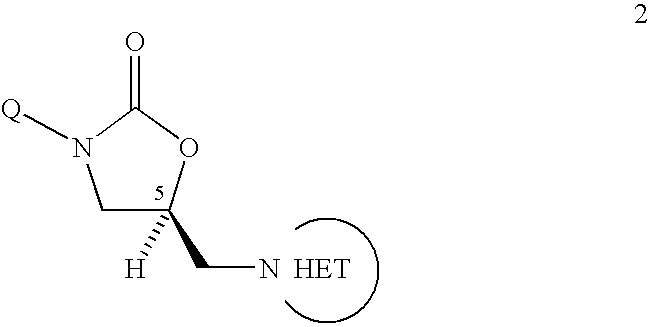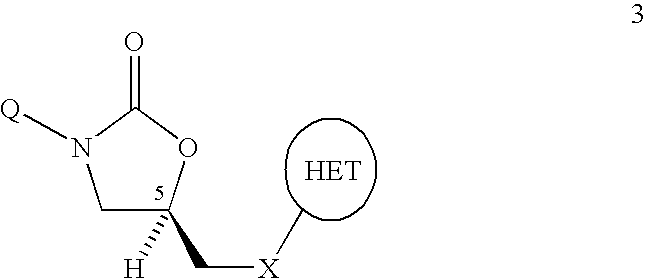Bifunctional heterocyclic compounds and methods of making and using same
a technology of bifunctional heterocyclic compounds and compounds, applied in the field of antiinfective, antiproliferative, antiinflammatory, prokinetic agents, etc., can solve the problems of cancerous cells resistant to chemotherapeutic drugs, cell or organism resistance to current effective therapeutic agents,
- Summary
- Abstract
- Description
- Claims
- Application Information
AI Technical Summary
Benefits of technology
Problems solved by technology
Method used
Image
Examples
example 1
Exemplary Oxazolidinone Derivatives
[0406] Exemplary compounds synthesized in accordance with the invention are listed in Table 2.
TABLE 2CompoundNumberStructure142143144145146147148149150151152153175176177178179180181182183184185186187203204205206207208209210211212213214215216217218219220221222223224225226227228229230231232233234235236237238239240241242243244245246247248249250251252361362363364365366367368369370371372373374375376377378379380381382383384385386387388389390391392393394395396397398399400401402403404405406407408409410411412413414415
example 2
Synthesis of Compounds 142 and 143
[0407] Scheme 28 below depicts the synthesis of compounds 142 and 143 using the chemistries previously exemplified. Briefly, 2-methylamino-ethanol was alkylated with propargyl bromide 154 and tosylate 155 to produce alkynes 156 and 157, respectively. Alkynes 156 and 157 were heated in the presence of the azide intermediate 158 (Brickner, S. J. et al. (1996) J. MED. CHEM 39: 673) to produce compounds 142 and 143, respectively.
Synthesis of Tosylate 155
[0408] 3-Butyn-1-ol (1.8 g, 25 mmol) was dissolved in methylene chloride (CH2Cl2) (40 mL) and triethylamine (Et3N) (4.18 mL, 30 mmol). The solution was stirred at 0° C. followed by addition of p-toluenesulfonyl chloride (5.05 g, 26.25 mmol). The reaction was allowed to warm to room temperature over a period of 1 hour and stirring was continued overnight. Thin layer chromatography (TLC) analysis (hexanes / ethyl acetate (EtOAc) 6:1) after 20 hours of reaction showed a complete consumption of 3-butyn-1-...
example 3
Synthesis of Compound 144
[0413] Scheme 29 below depicts the synthesis of compound 144 using the chemistries previously exemplified. Cycloaddition of azide 158 and alkyne 159 produced triazole 160. Tosylation of the alcohol of triazole 160, followed by alkylation with 2-methylamino-ethanol, produced 4-substituted triazole 144.
Synthesis of Alcohol 160
[0414] Azide 158 (0.15 g, 0.47 mmol) and 4-pentyn-1-ol (0.034 g, 0.39 mmol) were dissolved in anhydrous THF (10 mL) and Hunig's base (2 mL, 11.6 mmol). To this solution was added CuI (0.136 g, 0.7 mmol) and the resulting suspension was stirred at room temperature for 16 hours. TLC (CHCl3 / MeOH 10:1) showed a quantitative consumption of azide 158. Methylene chloride (30 mL) was added, the suspension was filtered and solvent was evaporated from the filtrate. The residue was purified on silica gel eluting with 5-7% MeOH in CH2Cl2 to provide 160 (0.077 g, 48.7%).
Synthesis of Triazole 144
[0415] Compound 160 (0.072 g, 0.178 mmol) was dis...
PUM
 Login to View More
Login to View More Abstract
Description
Claims
Application Information
 Login to View More
Login to View More - R&D
- Intellectual Property
- Life Sciences
- Materials
- Tech Scout
- Unparalleled Data Quality
- Higher Quality Content
- 60% Fewer Hallucinations
Browse by: Latest US Patents, China's latest patents, Technical Efficacy Thesaurus, Application Domain, Technology Topic, Popular Technical Reports.
© 2025 PatSnap. All rights reserved.Legal|Privacy policy|Modern Slavery Act Transparency Statement|Sitemap|About US| Contact US: help@patsnap.com



